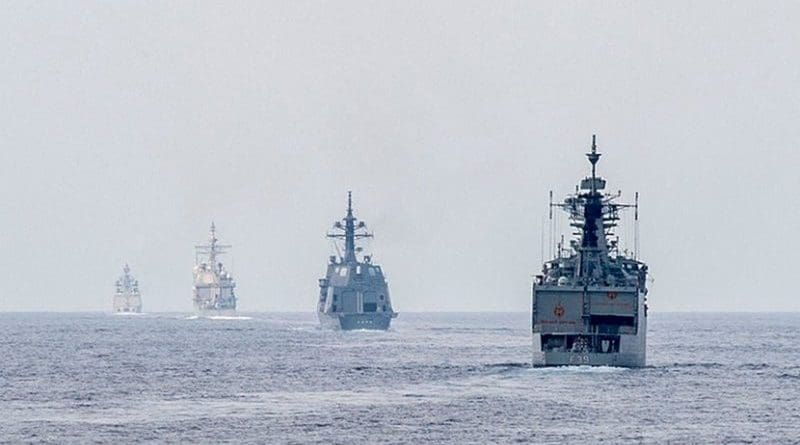Indo-Pacific: More Than Just A Buzzword – Analysis
By Observer Research Foundation
How can Asia’s democracies bring the Indo-Pacific to life?
By Rajeswari Pillai Rajagopalan
More and more countries are buying in to the Indo-Pacific construct. They must overcome the problems of coordination and burden-sharing if the concept is to have strategic teeth.
The idea of the Indo-Pacific is not entirely new, although it has certainly received much more attention in recent years. And as the result of changing power dynamics in Asia and beyond, many more countries are becoming comfortable with the construct.
In one of its earliest articulations, Japanese Prime Minister Shinzo Abe promoted the Indo-Pacific concept when he addressed a joint session of the Indian Parliament in 2007. As he spoke about the confluence of the two seas, he said “The Pacific and the Indian Oceans are now bringing about a dynamic coupling as seas of freedom and of prosperity. A ‘broader Asia’ that broke away geographical boundaries is now beginning to take on a distinct form.”
Former Indian Prime Minister Manmohan Singh, while addressing his East Asian counterparts at the India-ASEAN Commemorative Summit in 2012, noted that India seeks with them a future that is “inter-linked”, for which “a stable, secure and prosperous Indo-Pacific region is crucial.”
Similarly, former Indonesian Foreign Minister Marty Natalegawa called for a region-wide treaty to safeguard an Indo-Pacific “engine for global economic growth.”
Australia, in its 2013 Defence White Paper introduced the concept formally, becoming one of the first countries to officially adopt the term, which was only natural considering the two-ocean geography of the country.
Indian Prime Minister Narendra Modi talked about the Indo-Pacific concept recently at the Shangri-La Dialogue. He said: “India’s vision for the Indo-Pacific region is a positive one … India does not see the Indo-Pacific region as a strategy or as a club of limited members. Nor as a grouping that seeks to dominate. And by no means do we consider it as directed against any country.”
Though the term has been around for a few years, there is still a lack of clarity about its meaning. It broadly refers to the idea of the Indian and Pacific oceans as a single geographical construct, as Abe mentioned in his speech. While there are economic and other linkages that can be attached to the Indo-Pacific concept, it is the political, strategic, and possibly military aspects that have gained greater prominence because of the underlying geopolitical tensions in the region.
The idea of Indo-Pacific is that the Indian and Pacific oceans are increasingly a unified and shared strategic space. This implies that what happens in the Indian Ocean will impact on the Pacific Ocean.
Despite these differences, the number of countries embracing the term as a useful strategic idea has increased. Most recently, France reiterated the importance of the concept as its President Emmanuel Macron visited Australia. Using the term means acknowledging the strategic consequences of China’s rise and its muscular policies, and the general balancing strategy underway within Asia.
One of the reasons why India has embraced the term is because ‘Asia-Pacific’ is seen by many to exclude India, even though China’s rise affects everybody in the region. So, Indo-Pacific is a way for India to include itself in the Asia-Pacific, and for the Asia-Pacific to bring India into the mix. This is only natural. Given its geographical location above the Indian Ocean, India’s role cannot be ignored. A country with a vast coastline of 7,500 kilometres and 1,380 islands, more than two million square kilometres of Exclusive Economic Zone, and emerging blue water naval capabilities, will have an important role to play irrespective of geographical or definitional issues.
But it should also be noted that the Indo-Pacific plays out almost entirely as a maritime construct rather than a continental one.
There are a couple of problems that need to be faced. While the Indo-Pacific concept has gained greater salience for larger powers, there is more reluctance on the part of smaller countries because they are understandably concerned about a negative reaction from China. China has taken due note of the concept’s growing popularity and it could turn out to be a lot more aggressive in countering it in the coming years.
Another problem that has to be resolved is how to combine the different concerns, even if they are all about China. Many Pacific powers (Japan, US, Australia, New Zealand) want to focus on countering China’s power in the Pacific and the South China Sea. But India is obviously concerned more about China’s expansion into the Indian Ocean. Thus, there are those who argue that India’s Indian Ocean focus and its capacity constraints to exercise any serious power projection will limit New Delhi’s role. In the Indo-Pacific it will be diplomatic, economic and rhetorical.
The question is how to bring about better coordination between these two sets of concerns. For proponents of the Indo-Pacific, there is a need to start focusing on some form of burden-sharing. Without it, coordinated action – and the goal of making the Indo-Pacific concept more than just a strategic buzzword – is going to be difficult.
This article originally appeared in Asia & the Pacific Policy Society.

